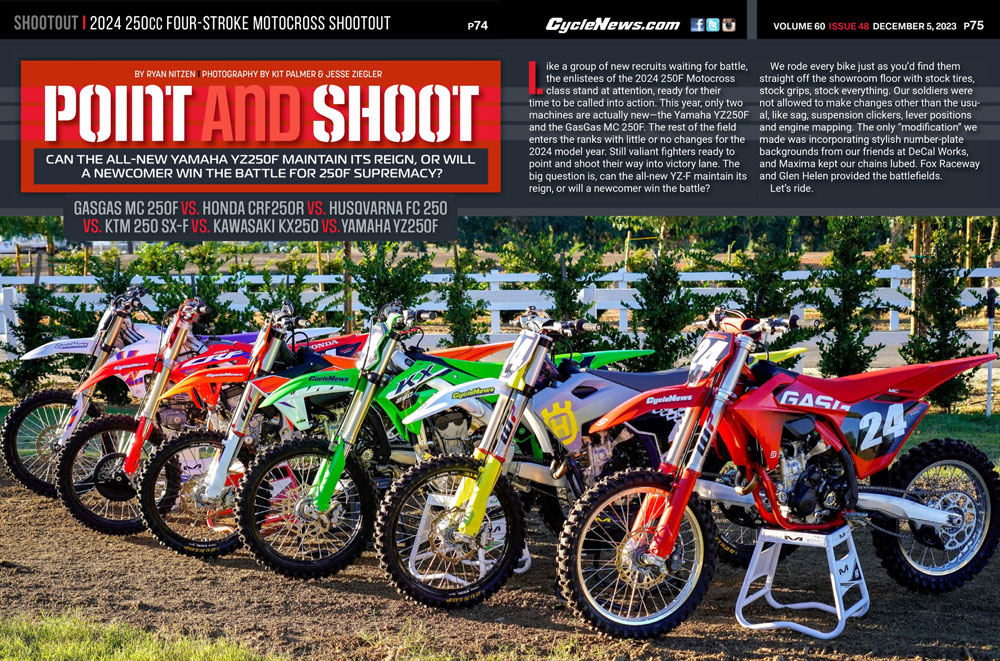Ryan Nitzen | December 11, 2023
Can the all-new Yamaha YZ250F maintain its reign, or will a newcomer win the battle for 250F supremacy?
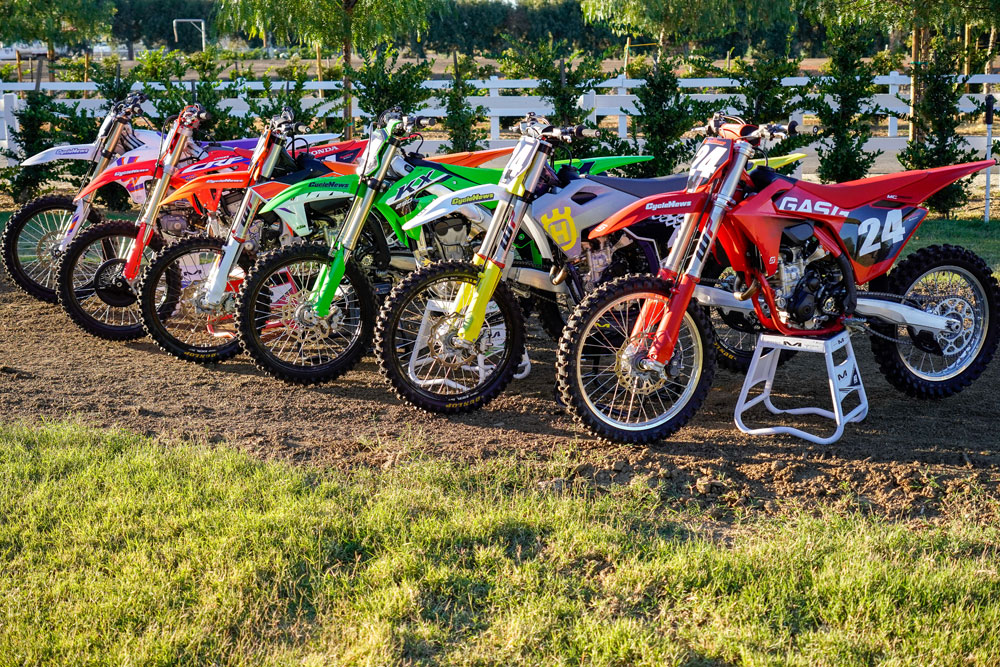
GasGas MC 250F vs. Honda CRF250R vs. Husqvarna FC 250 vs. KTM 250 SX-F vs. Kawasaki KX250 vs. Yamaha YZ250F
Photography by Kit Palmer & Jesse Ziegler
Like a group of new recruits waiting for battle, the enlistees of the 2024 250F Motocross class stand at attention, ready for their time to be called into action. This year, only two machines are actually new—the Yamaha YZ250F and the GasGas MC 250F. The rest of the field enters the ranks with little or no changes for the 2024 model year. Still valiant fighters ready to point and shoot their way into victory lane. The big question is, can the all-new YZ-F maintain its reign, or will a newcomer win the battle?
We rode every bike just as you’d find them straight off the showroom floor with stock tires, stock grips, stock everything. Our soldiers were not allowed to make changes other than the usual, like sag, suspension clickers, lever positions and engine mapping. The only “modification” we made was incorporating stylish number-plate backgrounds from our friends at DeCal Works, and Maxima kept our chains lubed. Fox Raceway and Glen Helen provided the battlefields.
Let’s ride.
The Recruits | 2024 250cc Four-Stroke Motocross Shootout
2024 KTM 250 SX-F
$10,199
Wet Weight: 237 lbs.
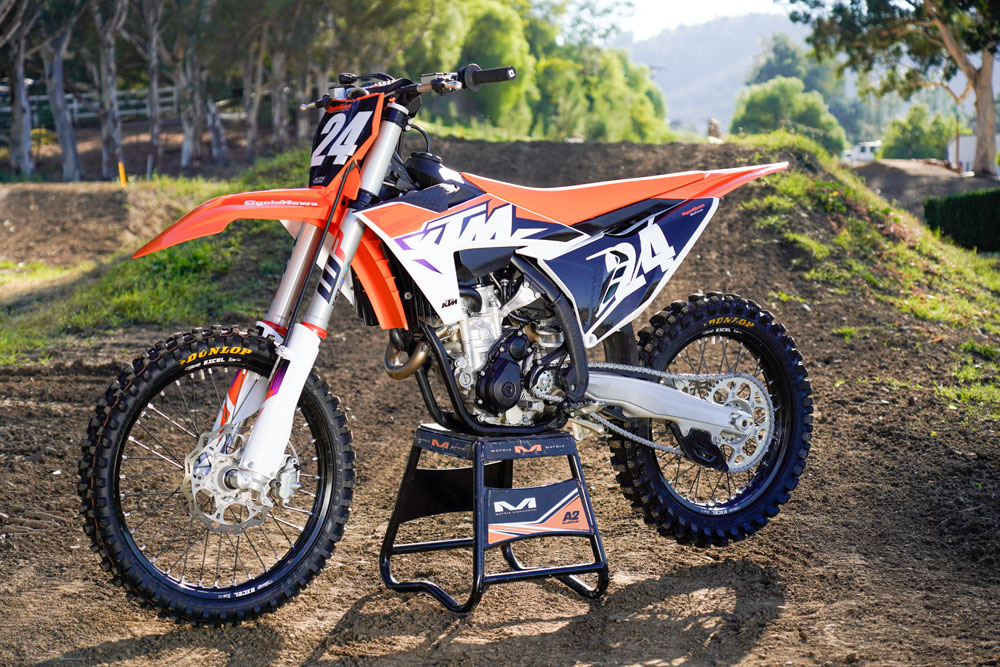
The KTM SX-F lineup received generational changes a year ago but comes into 2024 virtually unchanged. Last year, we saw an all-new frame, engine and bodywork adorning the flagship Austrian 250, all aimed at centralizing overall mass. Their “Ready To Race” mantra rings true in the opened airbox and an electronics suite complete with mapping switches, traction control and quick shift capabilities. The KTM is no longer the lightest bike in the class. However, its Brembo clutch, brake system and WP Xact suspension components are still considered premium features. Its price tag falls between its Husqvarna and GasGas relatives.
2024 GasGas MC 250F
$9399
Wet Weight: 240 lbs.
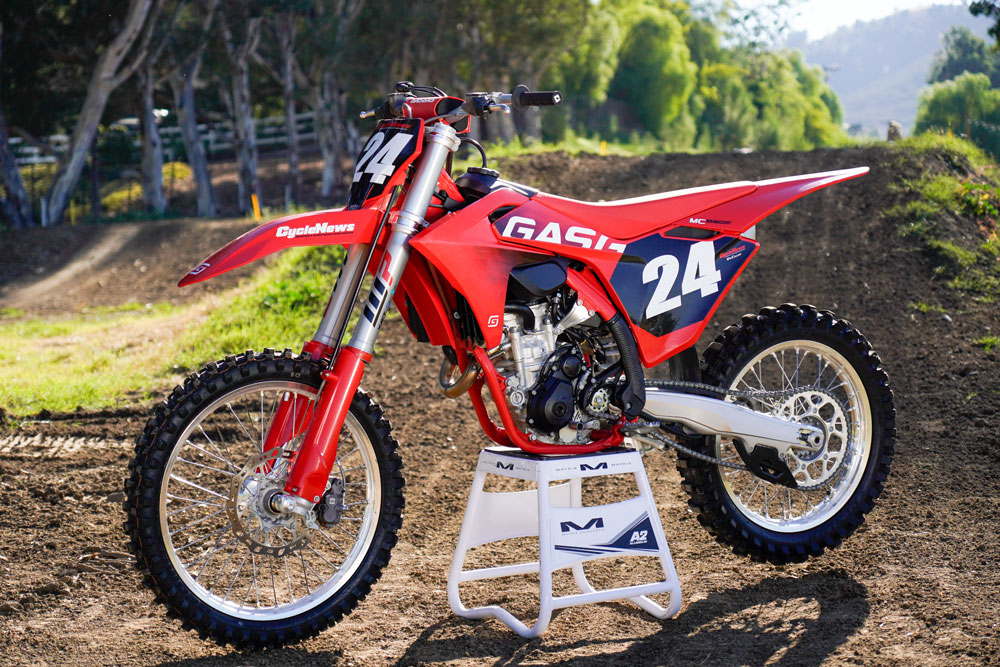
The GasGas MC 250F is one of two all-new bikes for the 2024 model year. While it is “all-new” for the GasGas brand, these changes are the same one’s consumers saw one year ago on the KTM and Husqvarna machines. A new frame, engine, swingarm and plastic bring the GasGas up to par with the other Austrian bikes. These updates also packed a few extra pounds, tipping our scales at 240 pounds. The GasGas’s suspension offers a softer “Euro-spec” setting along with Braketec brakes and a Braketec clutch. Since it lacks the mapping switch and traction control and comes with silver wheels, it is the least expensive of the three Austrian models.
2024 Kawasaki KX250
$8799
Wet Weight: 239 lbs.
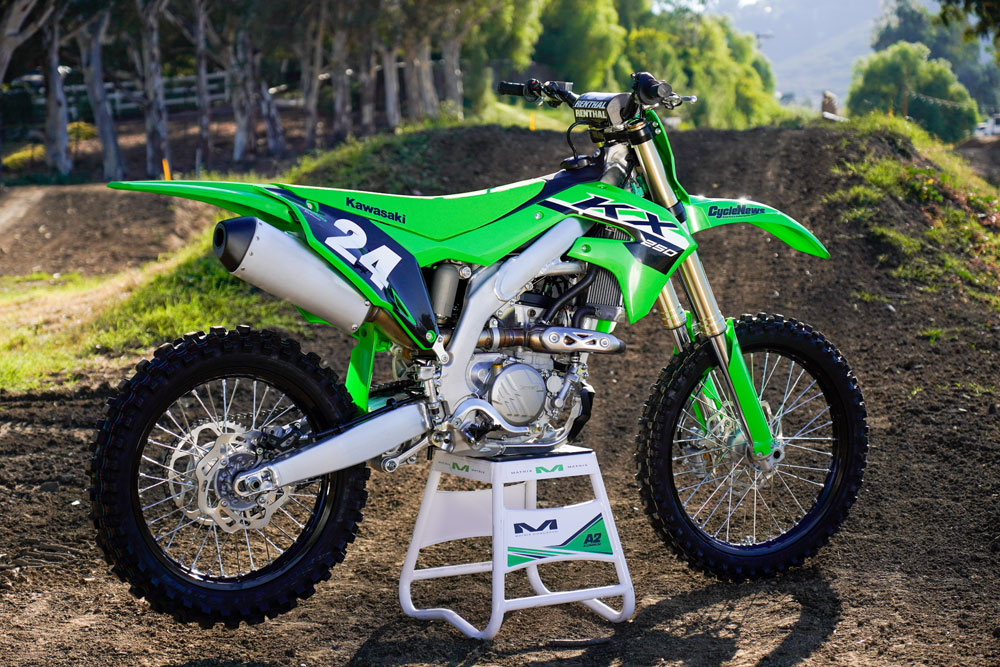
You won’t miss the 2024 Kawasaki’s KX250 on track with its bright lime green coloring, which it gets more of in 2024. And that’s about it. The green machine received a heavy mid-generation revamp in 2023, focusing on low-to-mid-range power. This was achieved via a longer exhaust header, a straighter downdraft intake, and a repositioned dual fuel injector system. A hydraulic clutch and three different programmable couplers come standard. Kawasaki’s ErgoFit system allows riders to reposition their handlebars and footpegs if desired.
2024 Honda CRF250R
$8299
Wet Weight: 231 lbs.
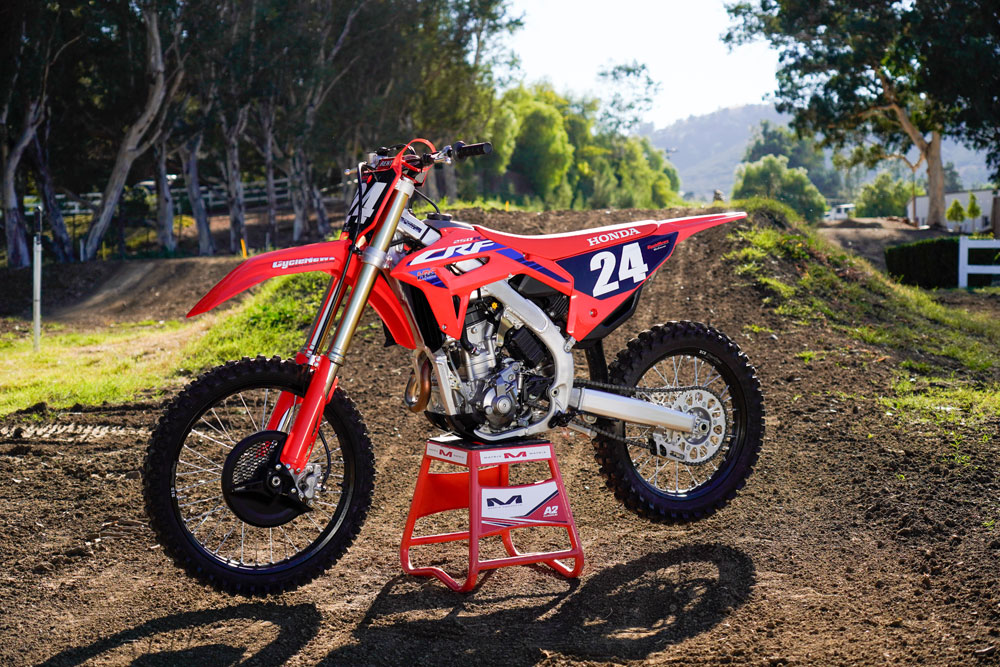
The Honda CRF250R is unchanged again for 2024, making it nearly the same as when this generation was introduced in 2022. The Honda rides on Showa suspension and offers three power modes with launch control. Pirelli Scorpion tires, a neutral rounded seat, and a cable-operated clutch highlight the Honda’s spec sheet. Despite it being unchanged yet again, the Honda is now the lightest bike on our scales of this group at 231 pounds fully fueled. The Honda didn’t get lighter; some of the others just got heavier.
2024 Yamaha YZ250F
$8899/$9099 (retro)
Wet Weight: 236 lbs.
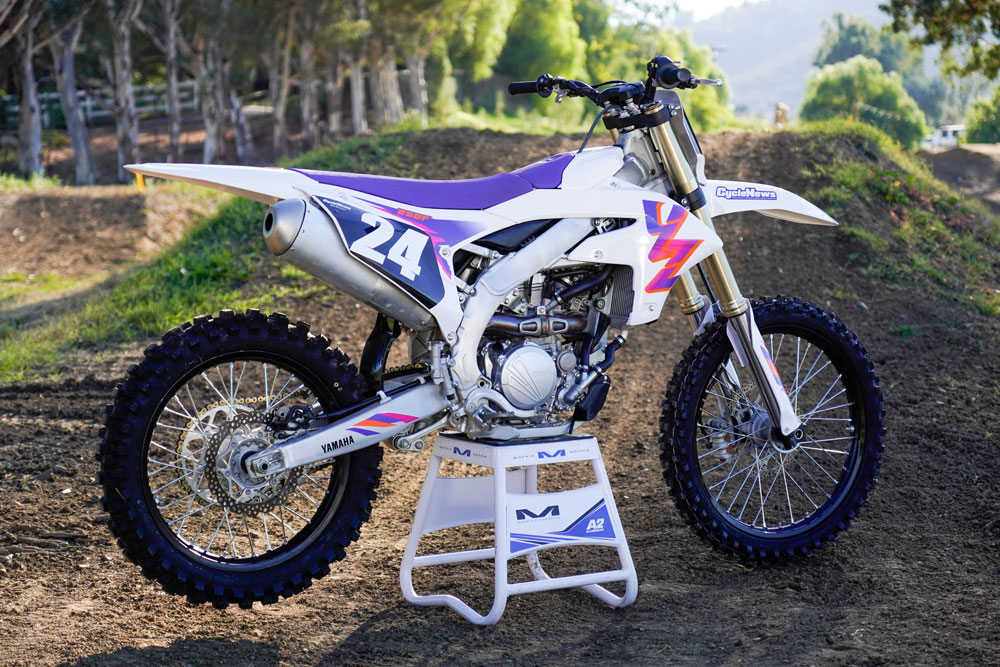
The Yamaha YZ250F is arguably the most anticipated 250F in the class for 2024. It enters a new generation and now shares the same chassis and slim bodywork as the YZ450F with virtually the same proven 250F engine as the previous generation. The cam chain was beefed up for added durability, and the airbox needed to be reworked to accommodate the new plastics. Yamaha’s Power Tuner App has been updated with easier-to-use functions. The YZ-F gained one pound from the 2023 model but is still the second lightest of the group.
In honor of the YZ’s 50th anniversary, Yamaha also offers the YZ250F in special white retro livery for $200 more than the traditional blue model.
2024 Husqvarna FC 250
$10,299
237 lbs.
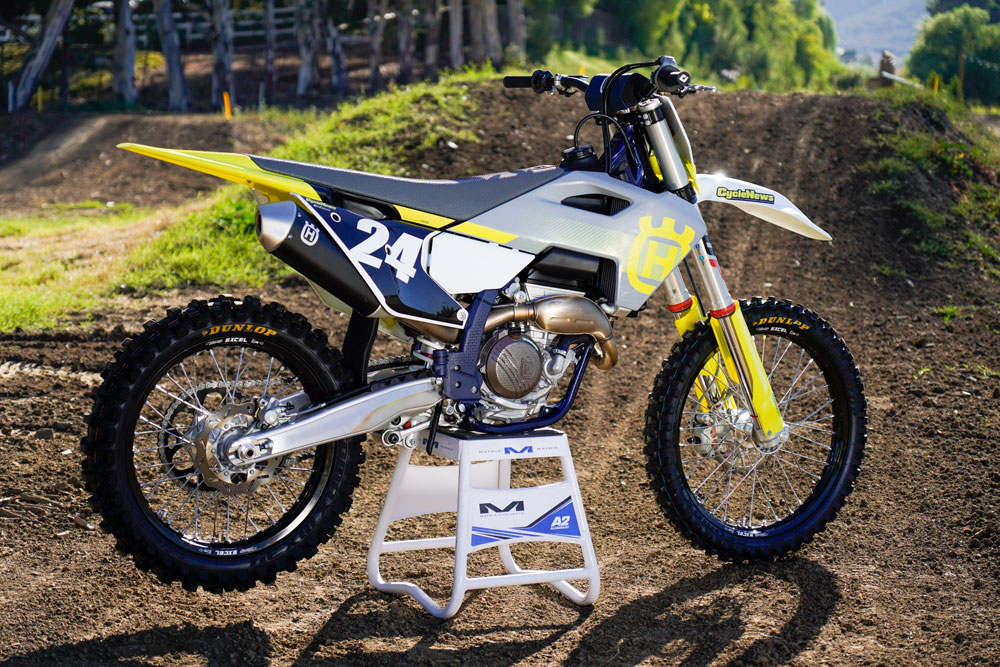
Going for the most “premium” bike in the class is the 2024 Husqvarna FC 250. It’s the third from the Austrians and the most expensive, by $100, of the bunch. The extra money gets you Brembo brakes and clutch, WP suspension, and all the electronics you could want. Sounds just like the KTM, right? That’s because the KTM and the Husqvarna are arguably the most similar they’ve ever been. The main differences are the apparent plastics and graphics, a sealed-off air box, and a 10mm lowered suspension on the Husky. The airbox is said to provide a mellower power character. At the same time, the lowered suspension drops the seat height by a difference of 0.8 inches compared to the KTM.
2024 Suzuki RM-Z 250
$8099
Wet Weight: 233.7 lbs. (claimed)
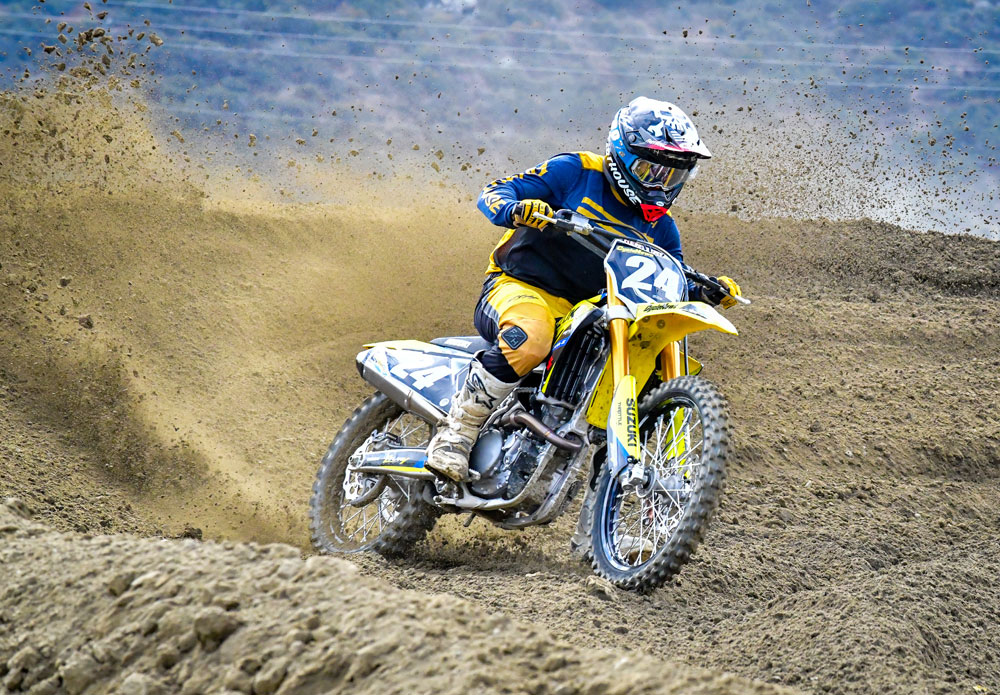
Even though the Suzuki RM-Z 250 is virtually unchanged again for 2024, we still brought our test bike to the shootout. What’s cool about this year’s version is the new RM Army Edition. If you buy a Suzuki before the end of the year, you’ll receive a full Pro Circuit Ti-6 Pro header and muffler, a pre-programmed map to match the exhaust, and a complete team-issue graphics kit for no extra cost. So, in our eyes, this is technically a stock 2024 RM-Z250.
Even with these upgrades, the bike still feels like years prior. The updated map and exhaust system certainly wake the ’Zook up at low rpm and encourage the rider to use all the bike’s horses. Plus, how can you not love the sound of a carbon-tipped PC pipe?! The graphics look good on the sharp Suzuki bodywork, too.
The bike is still down on horsepower, up on weight, and, need we say, still comes equipped with a kickstarter. It’s easy to criticize the RM-Z250, especially if you’ve still yet to ride one. Aside from the obvious, our testers had positive things to say about the Suzuki. Our expert riders praised it for its sharp handling and comfortable rider cockpit. Its manageable power character also allowed them to ride the bike to its potential without fear of it getting out from under them. The only reiterated complaint is the unbalanced chassis and harsh suspension.
With a few mods, the RM-Z can still be competitive, and we thank whoever signed off on approving the RM Army editions. Still, it finds itself out of the “official” test and in the back of the pack. It is, however, the least expensive of the group, which saves Suzuki die-hards some extra cash for the much-needed suspension modifications. The more brands, the better, and as long as Suzuki produces a 250cc motocrosser, you’ll find it in our lineup.
VIDEO | 2024 250cc Four-Stroke Motocross Shootout
2024 250cc 4-Stroke MX Shootout
6th Place |2024 250cc Four-Stroke Motocross Shootout
Honda CRF250R
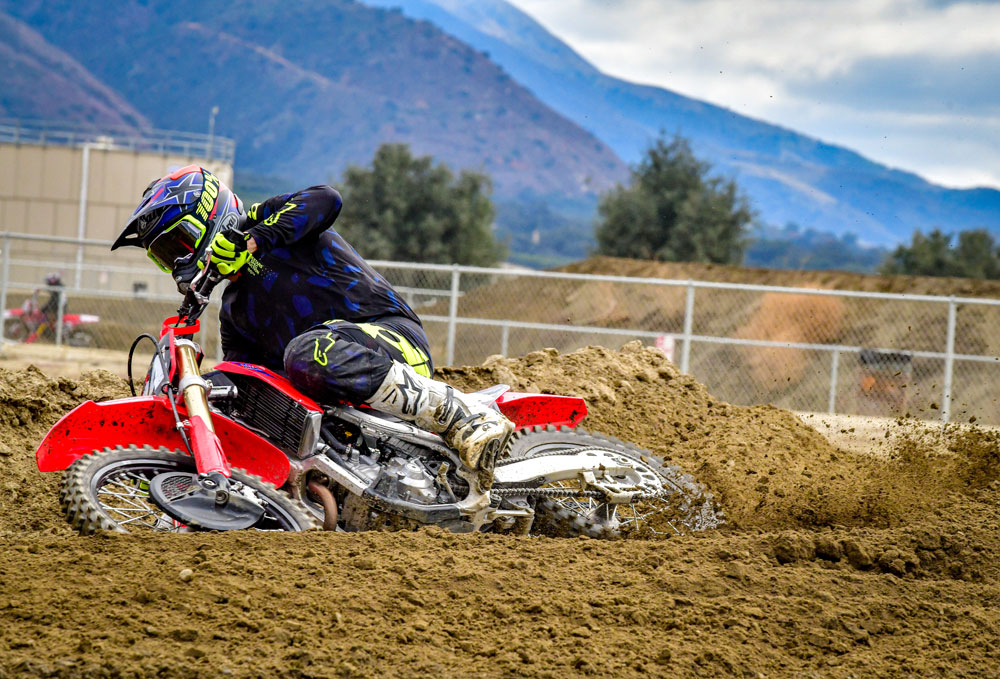
Rounding out the pack is the Honda CRF250R. It is unchanged again in 2024 and dropped a position from our shootout last year, with our testers complaining of, among other things, a lack of power compared to the other motorcycles. But not all is lost.
The Honda’s engine is ultra-friendly and great for novice-level riders. It’s smooth and offers a long, linear power character that climbs to the top of the revs without any real punch. The CRF’s chiller powerband allows a faster rider to push the bike to the redline, but our testers deemed it necessary to carry more speed on the Honda than the others. Mid-to-top is the sweet spot, but you just can’t pop out of deep inside lines like you can on the other machines. While all three maps are noticeably different on the Honda, some riders needed to double-check and ensure they were indeed in the faster map option. First-time 250F pilots will favor this engine, but budget some bolt-ons if you’re an intermediate or above-average racer.
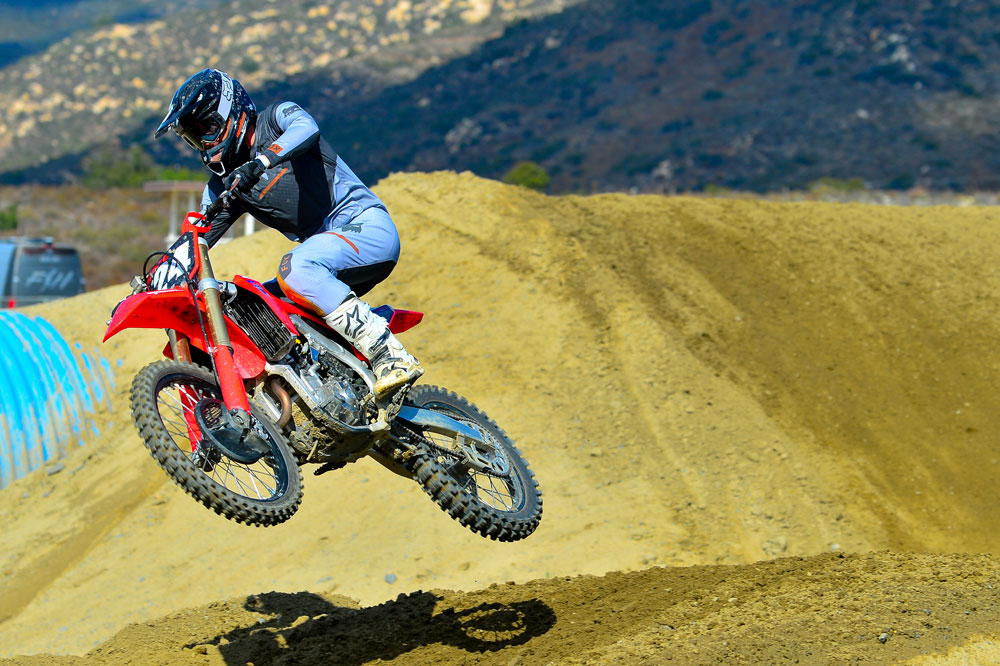
As far as overall rider cockpit, the Honda almost always ranks first. The comfortable and neutral layout of this generation’s riding position makes it an easy go-to for riders of all sizes. The rounded seat, adaptive bar position, and slim body styling are all strong suits for the CRF. The smooth cable clutch and brakes stay mounted to Renthal Fatbars, earning the Honda some bonus points.
The suspension and chassis departments are also some of the CRF’s weaker points. The bike is sharp and precise but equally stiff and harsh. The fork is oversprung and doesn’t gel well with the CRF’s rigid aluminum frame. You feel every bump from the front tire, up through the fork, and right into the rider’s hands. When the track is fresh, the bike feels agile and easy to pick lines, but this goes away as the track roughens up. The Honda demands to be ridden hard, but it’s held back by its overall mellower powerplant.
This bike is a dream on a smooth track, but aren’t all bikes? The slim profile and stiff nature make it easy to move the Honda where you want it. Switching lines on the fly or darting over to an inside seem easy. As we mentioned, point and shoot. It still turns like a Honda, being stable and planted through rutted corners with little to no rider input. It’s still too stiff.
5th Place | 2024 250cc Four-Stroke Motocross Shootout
Kawasaki KX250
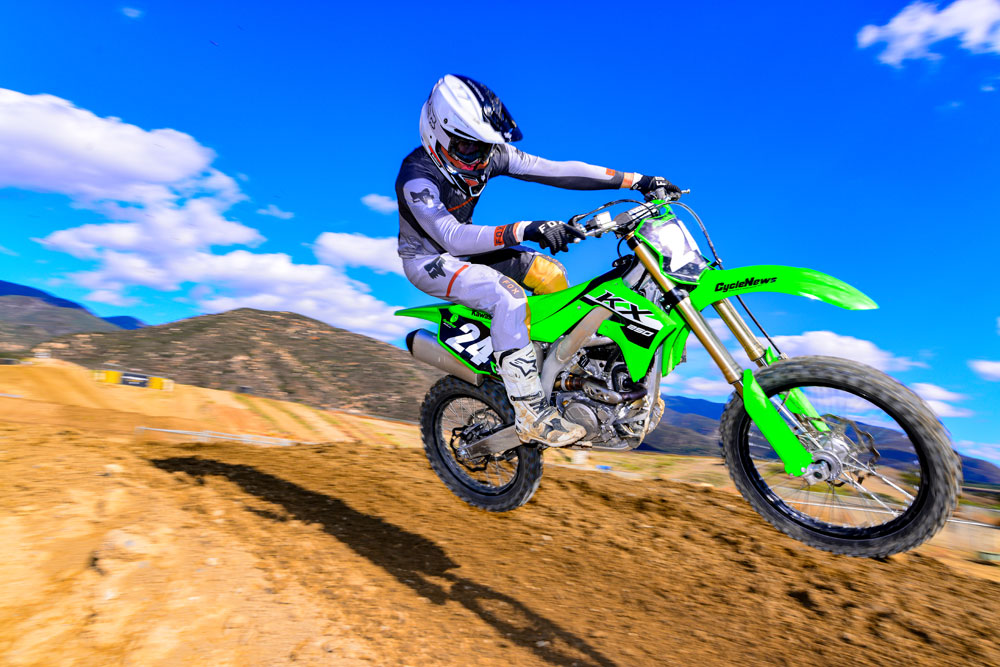
The fifth through third places were challenging to separate. It was a tough call that forced our riders into the nitty-gritty and pick apart these bikes. This year, the Kawasaki KX250 dropped off the podium and crossed our shootout finish line in fifth place.
The Kawasaki feels the fastest of the bunch, but you can’t win a shootout on sheer horsepower. It’s putting the power to the ground that really pays dividends. In the Kawi’s case, this potent motor is its best feature. The strong power is evident from the first lap as it blends a hearty bottom-end into a usable mid-to-top with plenty of over-rev. Gears carry to the furthest end of the revs, creating a broad feeling in any RPM without short shifting. All our riders opted for the more aggressive coupler. They ranked the Kawasaki engine at or near the top of the charts regarding the overall engine package. It’s worth mentioning that the Kawasaki is as loud or even a little louder than the notoriously ear-busting Yamaha.
The KX’s ergos are another plus. The traditional Japanese styling with a square seat and smooth lines feels right at home as soon as you hop on. Kawi’s ErgoFit system emphasizes its appeal to a variety of riders with adjustable handlebar and peg positions. The wide feeling footpegs aided in overall rider comfort. Kawasaki again opted for the hydraulic Nissin clutch and brake components, which work well in real-world conditions. Most riders seem split between favoring a cable or hydro clutch, but no one nagged the Kawasaki for its components. The vulcanized grips and slim levers are still as much of a weak point and the only real downside to the Kawi’s cockpit.
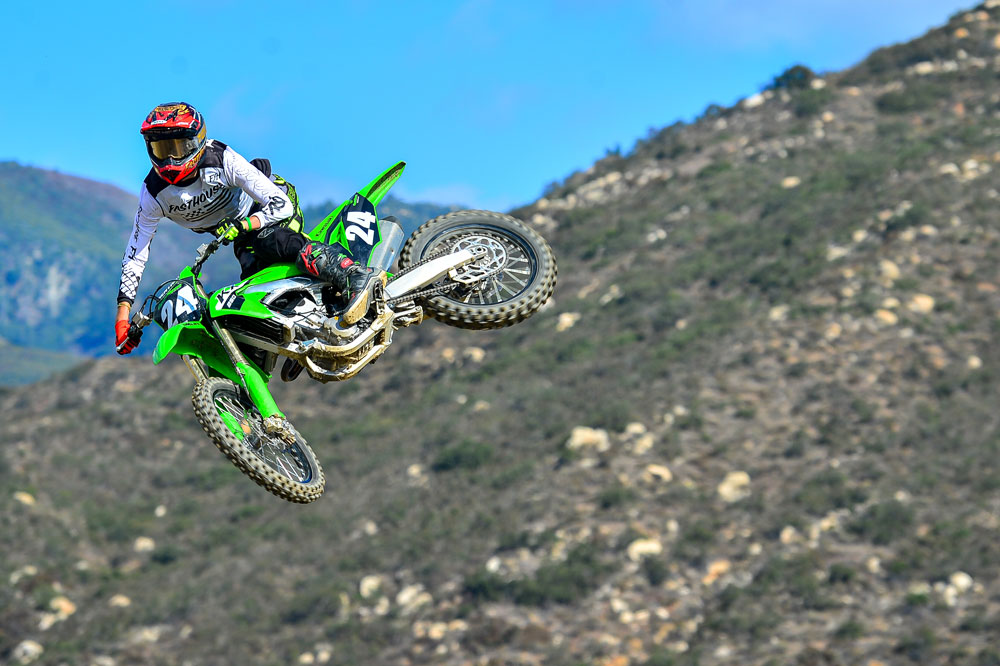
Two of the three Japanese bikes find themselves towards the tail end of the field for nearly the same reason. Like the Honda, the Kawasaki is outright too stiff. The harsh feeling from the fork and rigid chassis makes this bike hard to ride if the conditions aren’t just right. Again, the overly stiff fork puts force into the rider’s hands as you bounce your way through the late-day braking bumps. This made it hard to keep the bike straight and often stood the KX up in bumpy corners. The nervous front end is hard to get settled, and maneuvering this rigid character wears the rider out faster than the other bikes.
While the KX’s engine alone could easily win our shootout, it’s held back by an overly stiff chassis and harsh suspension setup. Our riders were expelling more energy on this bike while also being scared to trust it when the conditions weren’t ideal. This bike ranked as high as third for one tester who still agreed on the harshness issues.
4th Place | 2024 250cc Four-Stroke Motocross Shootout
GasGas MC 250F
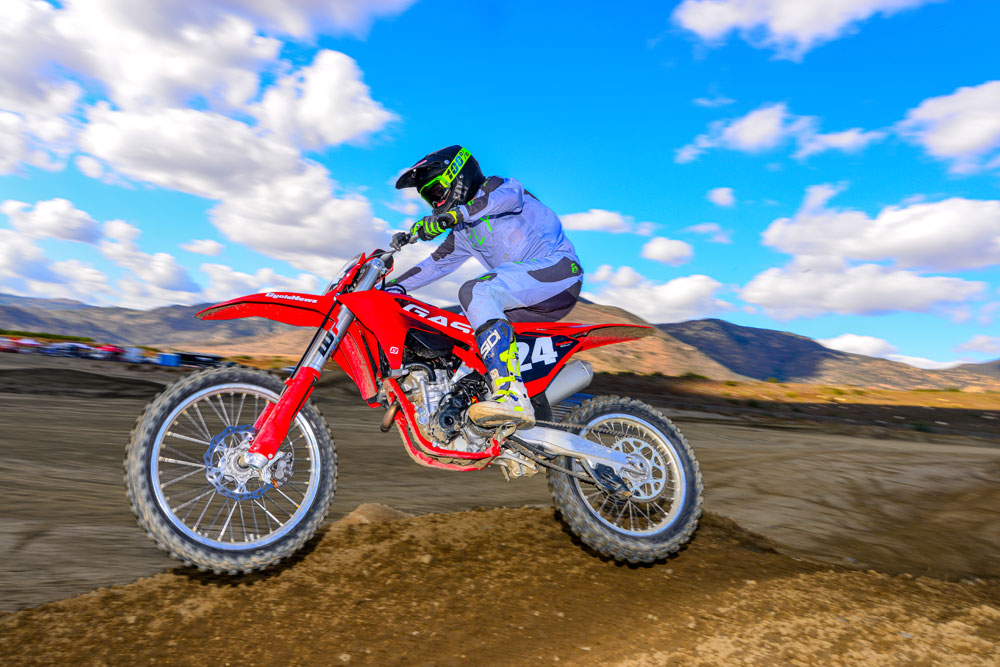
Just off the box in fourth place is the GasGas MC 250F. Having three similar Austrian machines puts the GasGas in a bit of no-man’s land. It’s not quite the KTM, and it’s also not a Husqvarna.
The GasGas is all-new this year, but it’s nothing innovative in terms of new tech or groundbreaking power. Instead, the GasGas brand is essentially one year behind its KTM and Husqvarna cousins. That means the ‘24 GasGas gets all the same updates that the ‘23 KTM received. Now, it rides on the new, stiffer chassis and has a more-consolidated engine design. These changes were felt immediately as the GasGas put on the “Freshman 15” and lost its spot as the lightest in the class.
What sets the GasGas apart from the other Austrians is the updated WP Xact suspension. Technically, they’re the same sticks you’ll find on the KTM, but GasGas opted for a “Euro-spec” setting this year. This equates to an overall softer feel on the track. We found the GasGas does a great job absorbing small bumps and felt easy to ride on a rough track. The softer spec isn’t bouncy or too springy, either. Its supple feel is a stark reminder of how used to the ultra-stiff settings we’ve become accustomed to. Late in the day, the GasGas was favored over some of the other rides, Austrians included. We felt this spec worked notably well with the newly updated European chassis and was the go-to for both faster and slower riders. The air forks still allow riders to fine-tune the “spring,” but we felt riders north of 200 pounds are likely to blow through and overuse the softer suspension function.
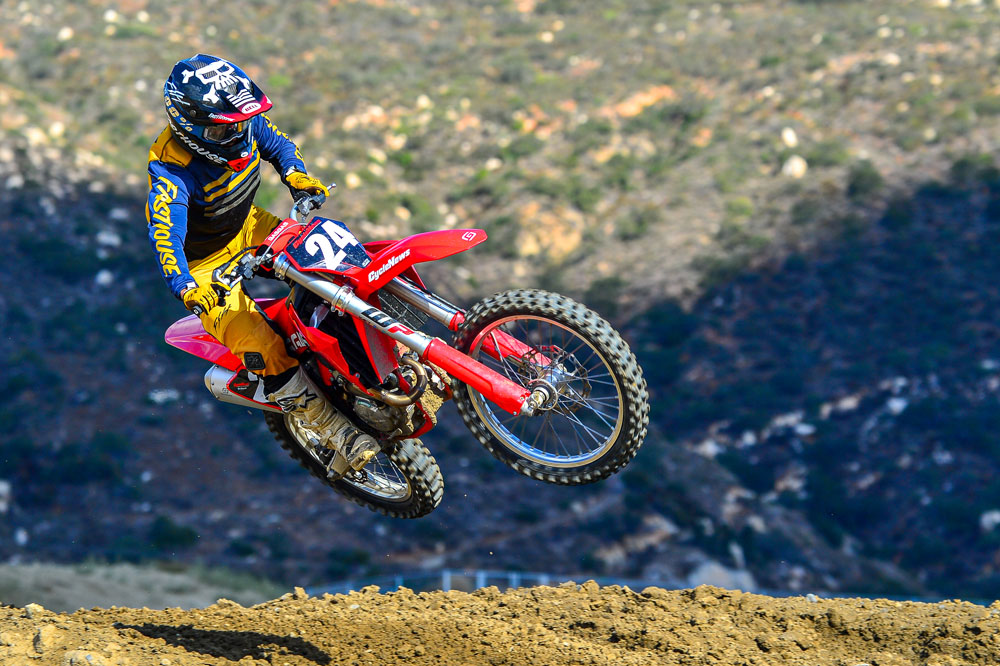
The engine package on the GasGas still generally feels like an Austrian bike. Still, a few things give the bike its own personality. The MC feels less aggressive off the bottom, which complements the softer suspension for less-experienced riders. This is also because the GasGas is stuck in the standard, more mellow map one. Without the aftermarket map switch, the bike lives in the tamer world of map one, which is noticeably smoother than the more aggressive map two. In the stock GasGas map, faster riders will enjoy the mid-to-top-range pull and push the bike well into the red zone as they look for the limiter. The airbox is also shaped differently than the other Austrian models, which furthers its smoother character.
With overall smoothness and rider comfort being on the menu for the GasGas, it’s still hard to rank it over its Euro relatives. The lack of maps, a three-pound weight difference, and the Braketec brakes and clutch systems don’t feel as precise as those on the KTM or the Husqvarna. That’s to be expected as GasGas is the more budget-friendly option in the Austrian lineup. It still has pluses, especially if you can live without some of the premium features.
Third Place | 2024 250cc Four-Stroke Motocross Shootout
Husqvarna FC 250
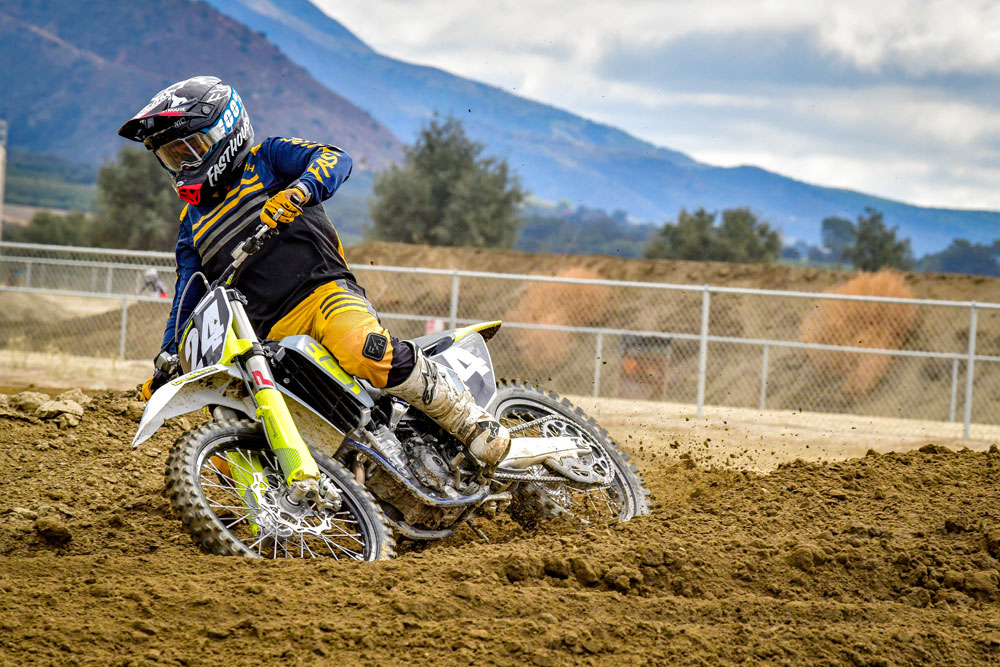
Just ahead of the rest and sneaking its way onto the podium is the Husqvarna FC 250. The KTM and Husqvarna are so closely related now that, at times, it can be hard to tell the difference without looking down at the front fender.
The Husqvarna retains its 10mm lower stance again in 2024. This puts the bike lower to the ground and, in turn, loses about a quarter-inch in overall suspension travel. This year, the big difference is the internal setting. Previously, the Husqvarna had essentially the same settings as the KTM, with 10mm shorter stanchions. This meant that no matter what, the fork and shock rode 10mm deeper in the stroke always. Now, there’s a specified setting for the Husqvarna, which gives it a better hold-up in all areas of the track.
Our two tracks offered contrasting conditions, allowing us to feel the good and the not-so-good from the Husqvarna camp. At Fox Raceway, the bike felt Velcroed to the ground. The Husqvarna is the hands-down winner of any flat corner. The lowered settings feel planted and stable as you navigate long ruts. All our riders gave the Husky a nod of approval for its stability in relatively smooth conditions.
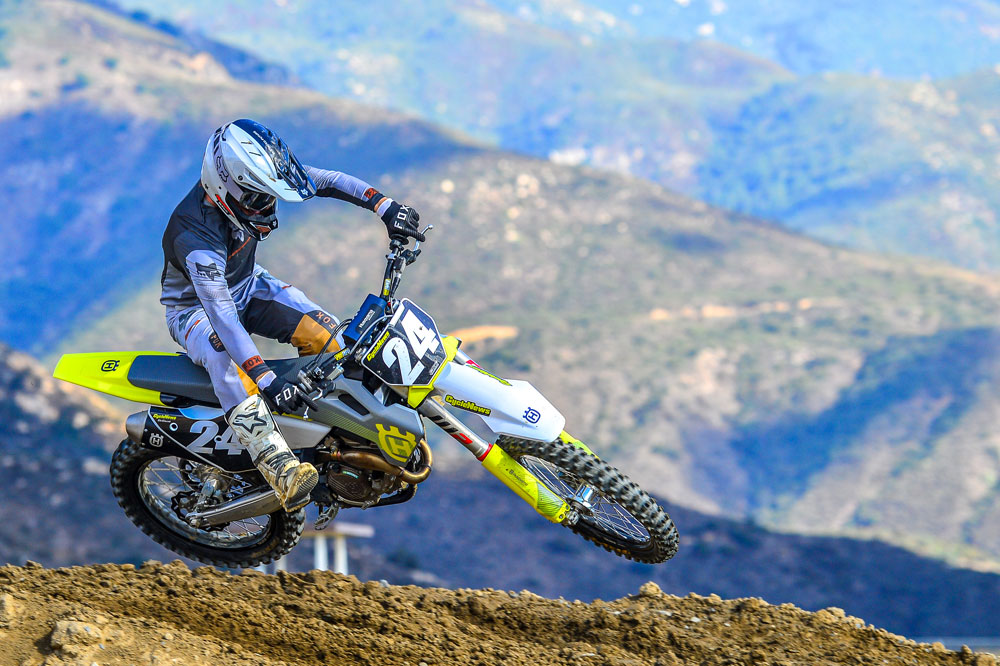
On the other hand, the conditions at Glen Helen were a far cry from those at Fox. The deep braking bumps felt much harsher on the FC than expected. This wasn’t an issue that could be solved by going faster. The faster we went, the worse it seemed to get! Rough and deep conditions are where the shorter suspension appeared to do the bike more harm than good.
Aside from the suspension, the engine was seen as a total asset. It’s slightly different from the KTM since the airbox is sealed off for less air and aims at a smoother overall character. We opted to run the vented side panel for maximum airflow. However, the bike still felt a bit mellower than its orange cousin, even in the faster map two. Initial roll-on is smooth, and the Husqvarna carries gears in a long and easy-to-ride manner. The full spread of electronics is nice to have, too, with two of our riders opting to run the quickshifter for most of both ride days.
We’re splitting hairs with the Husqvarna, the KTM, and even the GasGas. The Husqvarna nearly unanimously beat out the GasGas but beating the KTM was a different story. The higher price tag also weighed the bike down when considering what you get for the extra bucks. Due to its shortened suspension, let’s just say the Husqvarna came up about 10mm short of second place.
Second Place | 2024 250cc Four-Stroke Motocross Shootout
KTM 250 SX-F
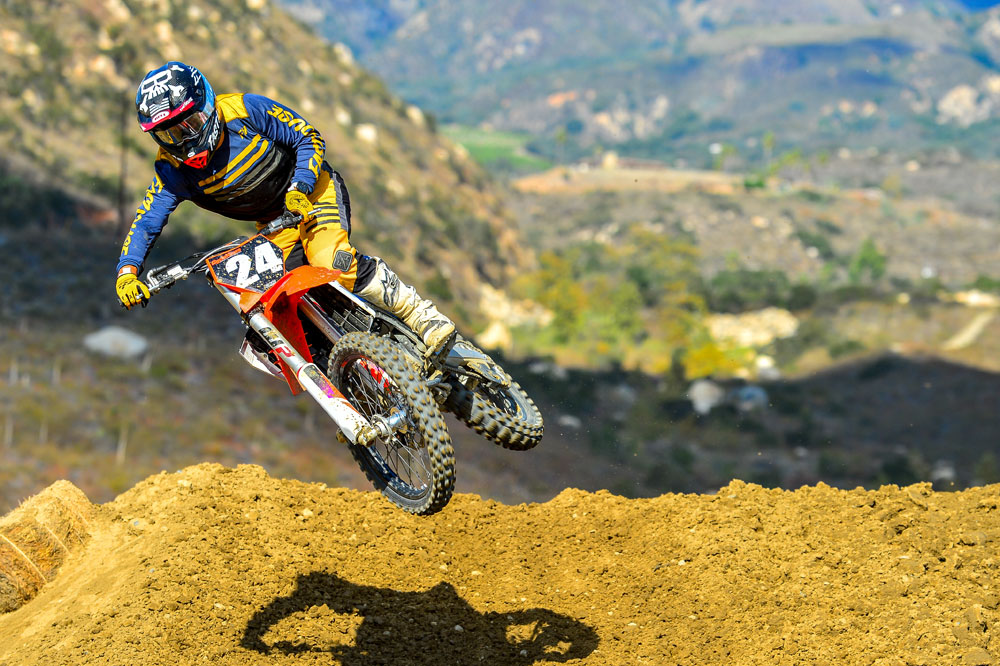
It’s another year where the KTM finds itself fighting for the top spot on the box. The top two bikes are the clear front runners in the group, but the KTM comes up just a few points shy of first place. This is the second year of the current-generation SX-F, and it’s a more well-rounded package.
The KTM is the best “all-arounder” of the Austrian bikes. It’s not soft like GasGas and not lowered like the Husqvarna. However, it retains all the best qualities we like from the other two machines. The KTM offers the full-length WP suspension with a more race-inspired setting, a complete set of electronics options, and a more vented airbox for maximum response.
The KTM’s power is some of the most usable in the class and certainly lives up to its “Ready To Race” motto. It offers strong torque from the bottom and a usable spread of low-to-mid-range before ramping up in the mid-to-top end. The new-gen engine keeps its high-revving Euro personality but doesn’t feel as high-strung as before. You can push it high into the red zone, but map two’s “aggressive” setting provides a more meaty torque character that can be lugged and ridden down low. The KTM is a more versatile setup that all ability levels will enjoy.
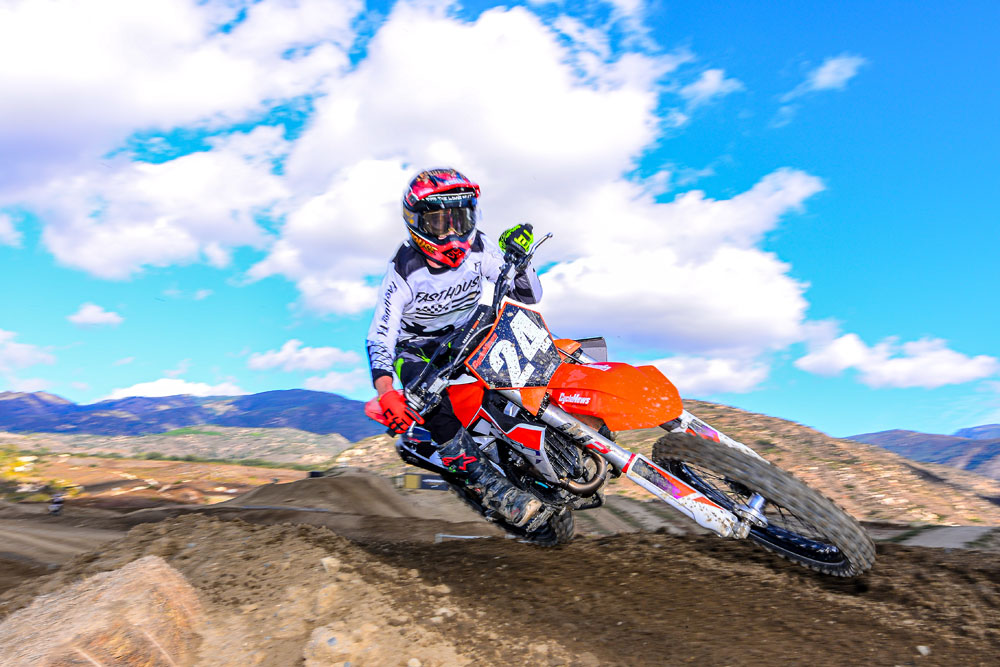
This chassis is undoubtedly stiffer across the board than the previous steel-frame KTM’s. That said, the KTM feels like the best overall package compared to the other steel-framed bikes. The WP Xact suspension components continue to improve year over year, and the air forks are up to par with any of the spring-loaded competitors. The WP forks felt best on the KTM, blending a comfortable top part of the stroke with progressive hold up down low. Riders felt that they could attack the track at any time of the day, with the KTM working well in any condition. Even with the new generation being heavier than before, the bike still feels agile on track, and the “extra” weight helps keep the bike planted to the ground.
The KTM’s fit and finish also bring it up to the bridesmaid position. Brembo brakes and clutch systems are some of the best in the business, and the ODI grips complete a universally comfortable cockpit. New footpegs and the squared gripper seat shape complete the rider triangle, further aiding in rider comfort. Every rider liked the KTM riding position, especially since it doesn’t feel as “foreign” as it did in years past. Riders also felt they were getting all the bells and whistles with the KTM having the map switch, traction control and quickshifter as standard options.
So, if it’s so good, why didn’t it win? The KTM is clearly a front-runner and almost unanimously finished second place. It’s the best bike in the European bunch and is undoubtedly a bike you could buy on Friday and race on Saturday. When riding back-to-back, our riders felt that the suspension and power weren’t as good as the first-place Yamaha, marking the fourth year in a row the KTM finished second in our ranks. All these bikes feel like the best when you only own one, which rings true with the SX-F. It’s when you put them head-to-head that others can reign supreme.
First Place | 2024 250cc Four-Stroke Motocross Shootout
Yamaha YZ250F
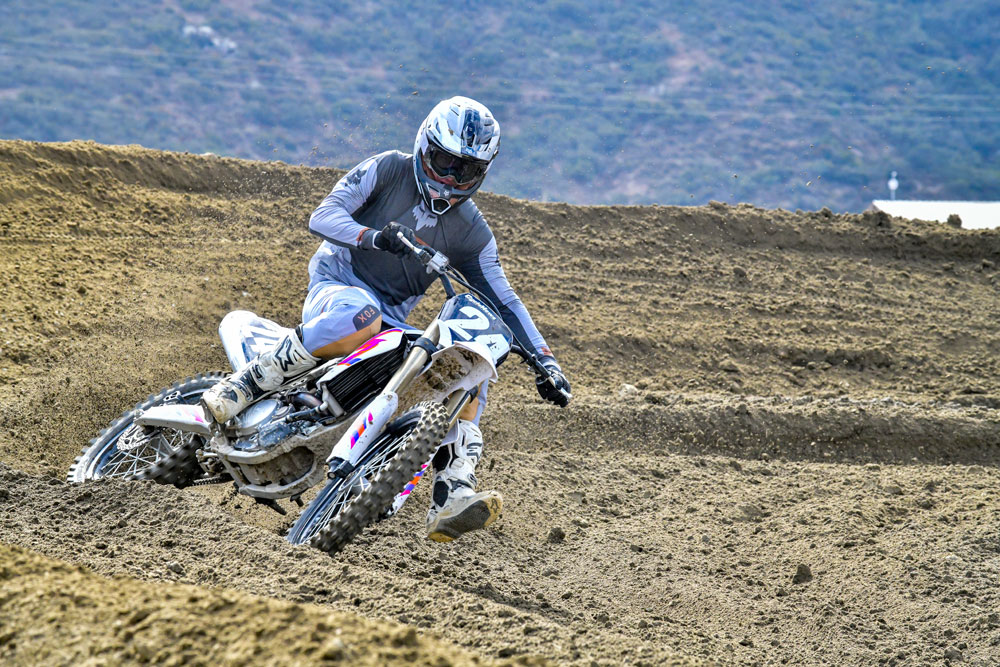
Call it a five-peat. Surprisingly, the Yamaha YZ250F takes the crown again. Why is that surprising? It’s rare that an all-new generation comes in and continues its current win streak. Usually, the first-year bugs are apparent and drop the overall rankings. But not the Yamaha.
Yamaha kept everything we liked about the ’23 model and ditched everything we didn’t. Year after year, we praised it for its potent engine and cloud-like suspension. Still, the wide radiator shrouds and rider cockpit were common complaints. The YZ-F’s new chassis is anything but that.
The razor-thin chassis encourages the rider to use the entire bike length as they move to the front of the cockpit. Tight turns, no problem. Squeezing the bike with your knees is easy. This is virtually the same frame and plastic used on the larger YZ450F, and the difference from the previous generation to the present is immeasurable. This is what the ’23 should’ve felt like. As usual, pegs, bars and levers are all on point with the YZ.
Power is another area where the YZ takes the cake. Yes, it’s essentially the same engine as the year prior, but it didn’t need to be changed anyway. At first, with the updated factory mapping, it does have a slightly different feel as it revs a tick slower than before and requires more input from the clutch to get it to spool up. With a quick trip to the Yamaha Power Tuner App, the techs uploaded their “Response” map, which solved all our complaints. This was the engine we remembered! Responsive torque off the bottom helps pull you out of the loamy insides without the dire need to short shift. The midrange feels prominent, but the YZ truly excels at the top end and over-rev. Riders noted they could hold it on the longest when riding the Yamaha without feeling out of control. It’s the best all-around engine that the fast guys and the vet riders voted number one.
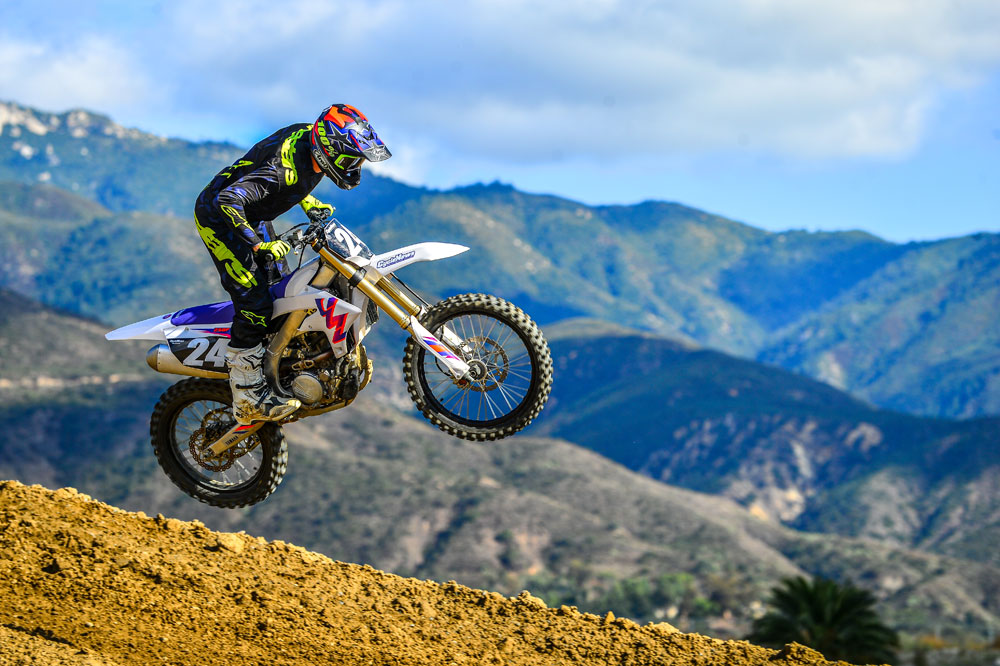
The KYB suspension further solidified the YZ’s rank. Small-bump absorption is immaculate, and a rough track doesn’t feel as bad on the Yamaha. The valving counteracts big hits from jumps or deep braking bumps as you move further into the stroke. Riding this bike late in the day made it feel like you were riding a totally different track, the fact that the chatter isn’t as noticeable. Suspension has long been one of Yamaha’s best qualities, and this year is no different. New adjusters on the fork caps also make trackside tuning a breeze. The new chassis is nimbler than before, but the suspension package is still well-balanced to keep the bike straight no matter the conditions.
It’s hard not to consider the bonus of the Yamaha Power Tuner smartphone app when ranking the YZ. Changing maps, scheduling maintenance, and a no-lie hour meter are things we can’t live without once putting them to the test. The ease of use and overall technological advantage earned the bike some extra brownie points from our practical-minded test riders.
Despite a unanimous number-one rank, we all shared common displeasures with the Yamaha. First, it’s loud. From the moment it starts to the highest range of the RPMs, the YZ clearly makes more noise than the rest of the bikes. If you ride a Yamaha, you’re likely used to this by now, but those who don’t might want to get a set of earplugs before rolling it out of the dealership. Second is the seat. The shape and density were noted as uncomfortable or too hard on a rough track. The strong power, agile chassis, and class-leading suspension were enough to make us overlook these “flaws.”
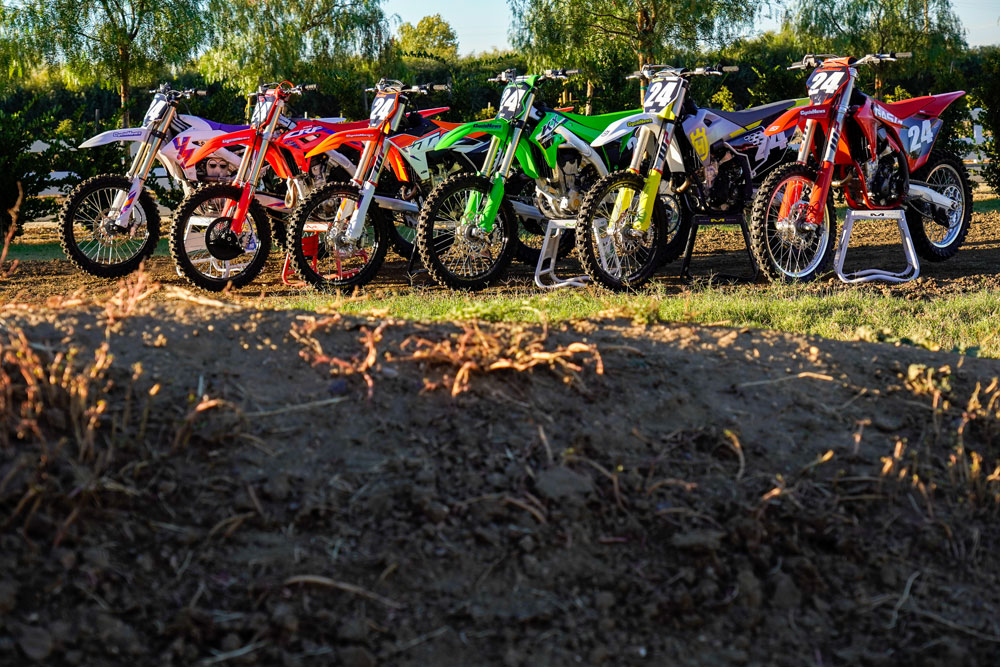
2024 250cc Four-Stroke Motocross Shootout | Wrap Up
Riding any of the latest 250F motocrossers is a dream come true. Nearly all of them pack some of the most sophisticated technology inside and make bikes from a decade ago look ancient. These could be the “best bike ever” if it was the only one in your fleet. It’s only when we put them back-to-back-to-back that the blemishes become visible. Even with that, a short list of modifications like an exhaust system or suspension re-valve would solve 99% of our complaints. Again, the Yamaha was the best machine straight out of the box. Despite being an all-new bike, its strong suits outgunned the competition for another year. CN
